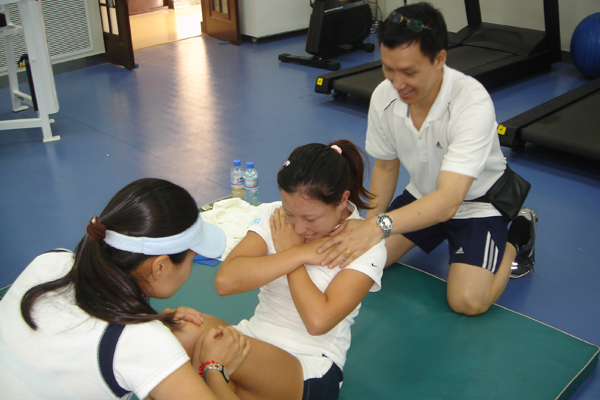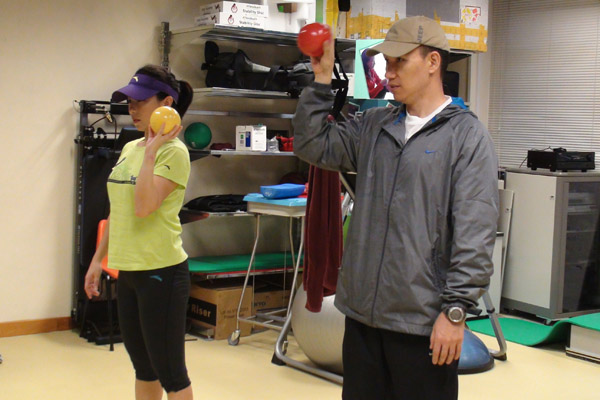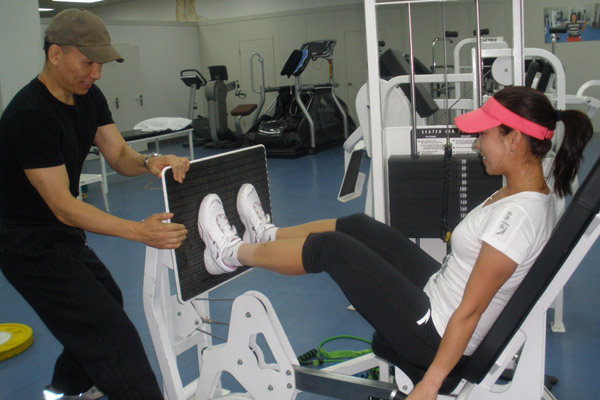
——The year 2006 was the year I had most the contact with the Golden Flower of Chinese Women’s Tennis, Zheng Jie—because of one of her feet.
● From Feburary issue of New Sports, 2012, dictated by Bob Chen, Written by Bai Qiang
In April 2006, as a member of the Expert Group of the General Administration of Sport of China, I went to Nanjing to visit with the Chinese Women’s Tennis Team, and met Zheng Jie for the first time. In my eyes, she did not have an outstanding physical condition, but she worked tenaciously, ran hard, and her playing relied on her fast-moving pace.
However, during our test on her lower limb strength, flexibility and explosiveness, Zheng Jie’s situation was not ideal. We once had her stand in the center of a hexagon, and jump to every corner and back with one foot, rotating clockwise three times. I was very surprised to discover that the performance of her left foot was not only much worse than her right foot, but also it could not control the direction when jumping. An examination of her foot revealed that the ligaments of her ankle joint had become loose and unstable, and therefore the “proprioceptive sense” of the joint control of her balance had declined. This caused the loss of sensitivity and speed, and led to other adverse consequences as well. The reason for this phenomenon is quite simple: the constant ankle sprains that had occurred during training and matches in the past.
So, I clearly pointed out in Zheng Jie’s diagnosis report that her left ankle would become the weak link during her training and competition, and it might even develop into a more major injury.
Sure enough, after Zheng Jie attended the French Open and Wimbledon, during a training session, she sprained her left ankle again. This time, the situation became more serious; her left foot not only lacked pedal force, but also could not brake during a run. A small piece of cartilage in the ankle joint was cut off, and had migrated among the intra-articular, which had caused swelling in the joint.
In my opinion, this emergence of a secondary injury is an inevitable vicious cycle. If we think about it, which competition or training did not aggravate the injury, or torment Zheng Jie’s already unstable left ankle?! On the clay court of the French Open, the ground surface is softer, mixed with sand, which requires the players’ ankles to withstand the constant sliding; on the grass court of Wimbledon, the rebound of the ball is low, therefore the players have to lower their center of gravity, which causes their feet to become more tired...
At that time, Zheng Jie was unable to exercise properly, and the hospital’s recommendation to her was to have surgery immediately to remove the cartilage inside the left ankle joint. As the main player for the Chinese Women’s Tennis Team, just four months away from the Doha Asian Games, it was not an option for Zheng Jie to give up this opportunity. Therefore, she decided to use the conservative sports training and rehabilitation method, which led to our first real cooperation.
I used the combined methods of traditional Chinese treatment and Western medicine to increase her blood circulation and eliminate the infections in her joints, and at the same time, with the goal of strengthening the ankle in mind, I put in a great deal of sports training rehabilitation exercise. In order both to maintain her strength and to keep her ankle from further injury, we put her into a pool to swim, move and run. In order to increase the strength of the ankle, we had her do weight-bearing exercises such as jumping from the floor using bungee cords, raising the heels, exercising with barbells, etc. We also arranged for her to run and jump in a sandpit barefoot. In order to improve her ankle’s reactivity, explosiveness, and the ability to move quickly, we followed the same method used to train football goalkeepers: having her dash out in an instant to catch balls coming from a variety of angles...
Most rehabilitation therapists would be satisfied to have brought their patients back to a state at which they walk with no pain, but our goal is to have the patients participate without pain in competitions and to act normally. Therefore, Zheng Jie’s sports training rehabilitation program was designed and implemented largely based on the requirements for the game of tennis. Some of the training was meant to let Zheng Jie do exercises that were either uncomfortable or too daring for her. This program, which was necessary not only to increase the difficulty of training, but also to control injuries, no doubt was conducted with a great risk.
For example, we simulated a sudden dangerous move on the tennis court intentionally to “make things difficult” for Zheng Jie: We placed a balance pad, which was as soft as a pillow, on the floor, and asked her to step quickly on, then immediately kick back. This seemingly simple action in fact requires extremely high stability in the athlete’s ankle joint; with one accidental slip, the ankle will be sprained. For Zheng Jie, who had already been injured and especially feared lateral movement, this was terrifying at the beginning; she moved very slowly and carefully with extreme nervousness, and her calves were very tired. But we ordered her to perform precisely, and in addition, to speed up her action of kicking until she reached the skilled and smooth state of development. Our thought was: we must have her reach the limit of her joint movement without surpassing it. Only then would her joint’s function make its maximal recovery, and the shadow in her heart would finally dissipate.
Our STaR program won’t allow any athlete to be “lazy.” Each event of the full content of 4 to 5 hours of STaR therapy is hard work, which pushed Zheng Jie to her limits. As soon as she got home, she hit the bed, but the next day she would appear tenaciously in front of me once again.


Three months later, Zheng Jie’s functional status had been restored to 90%, and she went to Doha as scheduled. Not long after, I received a text message from her to say that she got gold medals in both women’s singles and doubles at the Asian Games.


